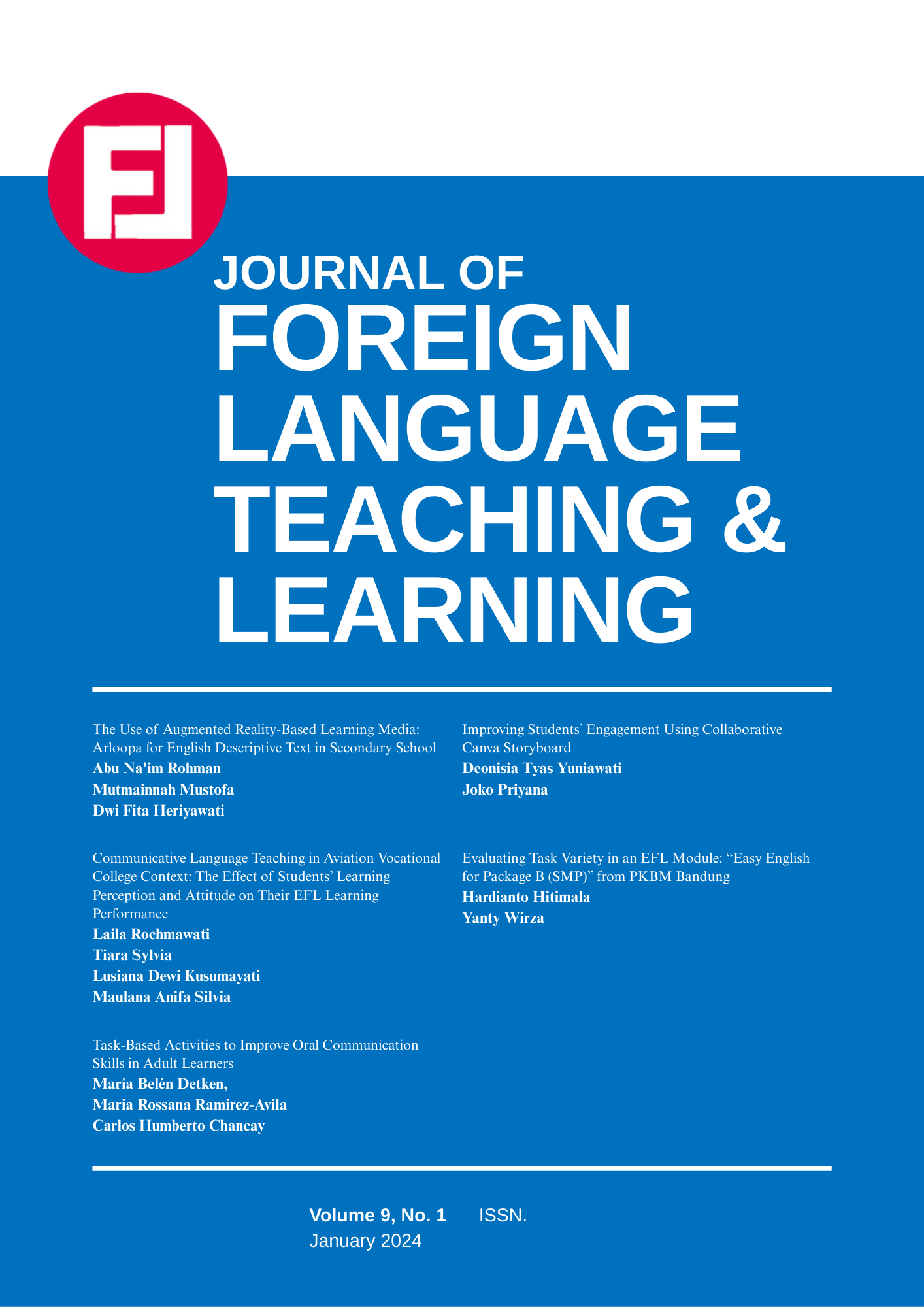Communicative Language Teaching in Aviation Vocational College Context: The Effect of Students’ Learning Perception and Attitude on Their EFL Learning Performance
DOI:
https://doi.org/10.18196/ftl.v9i1.20789Keywords:
CLT, EFL, learning attitude, learning perception, vocational collegeAbstract
This study examines the effect of learning perception and attitude on students' learning performance while implementing communicative language teaching (CLT) in a vocational college. The quantitative study used a survey research method with a cross-sectional design. 270 students participated in the study selected using a voluntarily random sampling technique. These research respondents were among those who had completed intermediate English classes with the amplification of the CLT method. Data were collected using a questionnaire with a four-point Likert's scaling method from very disagree (1) to very agree (4) (α = 0.843). The obtained data were analyzed using ANOVA with the assistance of IBM SPSS 25. Results showed a significant effect of learning perception (β = .890; F = 1018.849; p = 0.000) and attitude on students’ learning performance (β = .850; F = 698.468; p = 0.000). Among the two, learning attitude had been the more influential factor in students' learning performance during the implementation of CLT. This study suggested that CLT could be a catalyst for learning perception and attitude to elevate students' learning performance in the context of EFL teaching in vocational college.
References
A'yuni, Z. Q. (2021). A study on the implementation of Communicative Language Teaching (CLT) in EFL online classroom [Bachelor's thesis, FITK UIN Syarif Hidayatullah Jakarta]. https://bit.ly/3OhzYHp
Adem, H., & Berkessa, M. (2022). A case study of EFL teachers’ practice of teaching speaking skills vis-à-vis the principles of communicative language teaching (CLT). Cogent Education, 9(1). https://doi.org/10.1080/2331186X.2022.2087458
Ahir, K., Govani, K., Gajera, R., & Shah, M. (2020). Application on virtual reality for enhanced education learning, military training, and sports. Augmented Human Research, 5, 1-9. https://doi.org/10.1007/s41133-019-0025-2
Al Asmari, A. A. (2015). Communicative language teaching in EFL university context: Challenges for teachers. Journal of Language Teaching and Research, 6(5), 976-984. http://dx.doi.org/10.17507/jltr.0605.09
Al-Fraihat, D., Joy, M., & Sinclair, J. (2020). Evaluating e-learning systems success: An empirical study. Computers in Human Behavior, 102, 67–86. https://doi.org/10.1016/j.chb.2019.08.004
Al-Garni, S. A., & Almuhammadi, A. H. (2019). The effect of using communicative language teaching activities on EFL students' speaking skills at the University of Jeddah. English Language Teaching, 12(6), 72-86. https://doi.org/10.5539/elt.v12n6p72
Al-Khayyat, A. S. J. (2021). The impact of first language and audio-visual aids on students' vocabulary achievements. Al-Bahith Journal, 1(1). https://bit.ly/4bd1M9K
Alam, M. M. (2018). Challenges in implementing CLT at secondary schools in rural Bangladesh. IIUC Studies, 13, 93–102. https://doi.org/10.3329/iiucs.v13i0.37649
Alamri, W. A. (2018). Communicative language teaching: possible alternative approaches to CLT and teaching contexts. English Language Teaching, 11(10), 132–138. https://doi.org/10.5539/elt.v11n10p132
Albahri, M. A. (2021). Investigating Saudi tertiary teachers’ and learners’ attitudes toward communicative language teaching: A mixed-methods approach. [Doctoral Dissertation, Western Sydney University]. http://hdl.handle.net/1959.7/uws:67501
Alharbi, A. O. (2022). Issues with communicative language teaching implementation in Saudi Arabia concerning the government policy, teachers, and students: Two decades of research. Arab World English Journal, 13(2), 412–423. https://doi.org/10.24093/awej/vol13no2.28
Alluhaydan, H. M. (2024). The perceptions and attitudes of Saudi EFL students toward the use of communicative language teaching in oral communication classes. International Journal of English Language and Linguistics Research, 12(1), 1-23. https://doi.org/10.37745/ijellr.13/vol12n1123
Ansarey, D. (2012). Communicative Language Teaching in EFL contexts: Teachers attitude and perception in Bangladesh. ASA University Review, 6(1), 61–78.
Arini, M., & Wahyudin, A. Y. (2022). Students’perception on questionning technique in improving speaking skill ability at English education study program. Journal of Arts and Education, 1(2). https://doi.org/10.33365/jae.v2i1.70
Armnazi, M., & Alakrash, H. (2021). Factors affecting the application of communicative language teaching CLT in Syrian schools. TESOL and Technology Studies, 2(1), 1–14. https://doi.org/10.48185/tts.v2i1.143
Bhattacherjee, A. (2012). Social science research: Principles, methods, and practices. Digital Commons.
Basok, E. (2020). The gap between language teaching policies and classroom practices in the Turkish EFL context: The effects on teacher motivation. MEXTESOL Journal, 44(2), n2. https://bit.ly/3HxQpf5
Bhowmik, T., Majumdar, S., Choudhury, A., Banerjee, A., & Roy, B. (2023). Importance of internal and external psychological factors in digital learning. In: Choudhury, A., Biswas, A., Chakraborti, S. (eds) Digital Learning based Education. Advanced Technologies and Societal Change. Springer, Singapore. https://doi.org/10.1007/978-981-19-8967-4_8
Bouchrika, I., Harrati, N., Wanick, V., & Wills, G. (2021). Exploring the impact of gamification on student engagement and involvement with e-learning systems. Interactive Learning Environments, 29(8), 1244–1257. https://doi.org/10.1080/10494820.2019.1623267
Brown, H. D. (2014). Principles of language learning and teaching: A course in second language acquisition. Pearson.
DeMonte, J. (2013). High-quality professional development for teachers: Supporting teacher training to improve student learning. Center for American Progress. https://files.eric.ed.gov/fulltext/ED561095.pdf
Dİilber, E., & Komur, Ş. (2022). The role of two-way information-gap tasks on students’ motivation in speaking lessons in an ESP context. Language and Technology, 4(1), 2-14. https://doi.org/10.55078/lantec.1118527
Dos Santos, L. M. (2020). The discussion of communicative language teaching approach in language classrooms. Journal of Education and E-Learning Research, 7(2), 104–109. https://doi.org/10.20448/journal.509.2020.72.104.109
Garton, S., Copland, F., & Burns, A. (2011). Investigating global practices in teaching English to young learners. ELT Research papers, 11(1), 1–24.
Gibson, E. J. (1994). An odyssey in learning and perception. MIT Press.
Greenwald, A. G. (1968). On defining attitude and attitude theory. In L. Festinger & S. Schachter (Eds.). Social Psychology: A series of monographs, treatises, and texts. Psychological (pp. 361-388). Academic Press, Inc.
Hakim, I. (2022). Exploring the challenges of communicative language teaching in Indonesian context from a constructivist perspective. ELS Journal on Interdisciplinary Studies in Humanities, 5(1), 1–11. https://doi.org/10.34050/elsjish.v5i1.19163
Han, I. (2022). Contextualization of communicative language teaching in Confucian heritage culture: challenging pedagogic dichotomization. SAGE Open, 12(1), 215824402210798. https://doi.org/10.1177/21582440221079895
Heggernes, S. L. (2021). A critical review of the role of texts in fostering intercultural communicative competence in the English Language classroom. Educational Research Review, 33, 100390. https://doi.org/10.1016/j.edurev.2021.100390
Ho, Y. Y. C. (2020). Communicative language teaching and English as a foreign language undergraduates’ communicative competence in tourism English. Journal of Hospitality, Leisure, Sport & Tourism Education, 27, 100271. https://doi.org/10.1016/j.jhlste.2020.100271
Hosseini, S. M., Hesam, S., & Hosseini, S. A. (2023). Burnout among Military Personnel: A systematic review. Iranian Journal of Psychiatry, 18(2), 213-236. https://doi.org/10.18502/ijps.v18i2.12371
Khatib, M., & Tootkaboni, A. A. (2019). Attitudes towards communicative language teaching: the case of EFL learners and teachers. Íkala, 24(3), 471–485. https://doi.org/10.17533/udea.ikala.v24n03a04
Kim, K., Oh, I. S., Chiaburu, D. S., & Brown, K. G. (2012). Does positive perception of oneself boost learning motivation and performance? International Journal of Selection and Assessment, 20(3), 257-271. https://doi.org/10.1111/j.1468-2389.2012.00598.x
Komol, T., & Suwanphathama, S. (2020). Students’ perceptions and attitudes toward the use of communicative language teaching (CLT) to improve English listening and speaking skills. English Language and Literature Studies, 10(4), 40. https://doi.org/10.5539/ells.v10n4p40
Kustati, M., Yusuf, Y. Q., & Maarof, N. (2018). English teachers’ voices on communicative language teaching for reading in Indonesian rural classrooms. Problems of Education in the 21st Century, 76(5), 649–662. https://doi.org/10.33225/pec/18.76.649
Lee, S., & Ogawa, C. (2021). Online teaching self-efficacy—how English teachers feel during the Covid-19 pandemic. Indonesian TESOL Journal, 3(1), 1-17. https://ejournal.iainpalopo.ac.id/index.php/ITJ/article/view/1744
Liu, C. (2020). Motivators for demotivators affecting EFL learners in Chinese secondary vocational school. English Language Teaching, 13(4), 41–51. https://doi.org/10.5539/elt.v13n4p41
Liunokas, Y. (2021). The efficacy of using communicative language teaching (CLT) in teaching writing descriptive text to Indonesian English as foreign language (EFL) students. IDEAS: Journal on English Language Teaching and Learning, Linguistics and Literature, 9(1), 514-519. https://ejournal.iainpalopo.ac.id/index.php/ideas/article/view/1905
Long, Y. (2023). Research on oral English teaching strategies in junior high school based on communicative language teaching. The Educational Review, 7(5), 620–624. https://doi.org/10.26855/er.2023.05.016
Losi, R. V., & Nasution, M. M. (2022). Students' attitudes toward communicative language teaching (CLT) in English speaking intensive program. International Journal of English and Applied Linguistics (IJEAL), 2(1), 95-102. https://doi.org/10.47709/ijeal.v2i1.1428
Mahmoudi, S., & Mahmoudi, A. (2015). Internal and external factors affecting learning English as a foreign language. International Journal of Language and Linguistics, 3(5), 313-322. https://doi.org/10.11648/j.ijll.20150305.16
Mandasari, B. (2020). The impact of online learning toward students’ academic performance on business correspondence course. EDUTECH: Journal of Education and Technology, 4(1), 98-110. https://doi.org/10.29062/edu.v4i1.74
Mangaleswaran, S., & Aziz, A. A. (2019). The impact of the implementation of CLT on students’ speaking skills. International Journal of Scientific and Research Publications (IJSRP), 9(4), p8814. http://dx.doi.org/10.29322/IJSRP.9.04.2019.p8814
McIlroy, G., & Efthymiou, M. (2023). Air traffic control officer recruitment and training. In M. Efthymiou (Ed.). Air traffic management: Principles, performance, and markets. (pp. 61–83). Routledge.
Nam, H. (2023). Challenges and constraints of implementing communicative language teaching: Teacher-related vs. non-teacher-related factors. LEARN Journal: Language Education and Acquisition Research Network, 16(1), 75–96. https://so04.tci-thaijo.org/index.php/LEARN/article/view/263434
Namaziandost, E., Alekasir, S., Hassan Mohammed Sawalmeh, M., & Miftah, M. Z. (2020). Investigating the Iranian EFL learners’ attitudes towards the implementation of e-portfolios in English learning and assessment. Cogent Education, 7(1), 1-32. https://doi.org/10.1080/2331186X.2020.1856764
Öden, M. S., Bolat, Y. İ., & Goksu, İ. (2021). Kahoot! as a gamification tool in vocational education: More positive attitude, motivation, and less anxiety in EFL. Journal of Computer and Education Research, 9(18), 682-701. https://doi.org/10.18009/jcer.924882
Pallant, J. (2020). SPSS survival manual: A step by step guide to data analysis using IBM SPSS. McGraw-Hill Education.
Phillipson, L., & Hammond, A. (2018). More than talking: A scoping review of innovative approaches to qualitative research involving people with dementia. International Journal of Qualitative Methods, 17(1), . https://doi.org/10.1177/1609406918782784
Ramli, N., Muljono, P., & Afendi, F. M. (2018). External factors, internal factors, and self-directed learning readiness. Journal of Education and e-Learning research, 5(1), 37-42. https://doi.org/10.20448/journal.509.2018.51.37.42
Rezalou, A., & Yagiz, O. (2021). EFL students’ perceptions and attitudes toward using communicative activities in clt classroom. Shanlax International Journal of Education, 9, 112–124. https://doi.org/10.34293/education.v9iS2-Sep.4376
Rochmawati, L., Fatmawati, & Sukma, M. M. (2023). Motivation, anxiety, and self-efficacy in learning aviation English: A study of Indonesian aviation cadets. Asian-Pacific Journal of Second and Foreign Language Education, 8(1), 40. https://doi.org/10.1186/s40862-023-00212-6
Rostan, R. B., & Pammu, A. (2023). Teacher's communicative language teaching (CLT) strategies in improving the speaking ability of the hospitality students (A case study at SMKN 5 Barru). Journal of Namibian Studies: History Politics Culture, 33, 2831-2851. https://doi.org/10.59670/jns.v33i.907
Shahid, C., Abbasi, I. A., & Bhutto, S. (2022). Improving communicative competence through CLT approach in second language learning at the undergraduate level. Pakistan Journal of Humanities and Social Sciences, 10(4), 1472–1486. https://doi.org/10.52131/pjhss.2022.1004.0305
Shchegoleva, A.V., Anisimova, E.S., Vorobets, L.V. (2021). Using Audiovisual Aids to Develop Communicative Competence in Aviation English. In: Solovev, D.B., Savaley, V.V., Bekker, A.T., Petukhov, V.I. (Ed.s) Proceeding of the International Science and Technology Conference "FarEastСon 2020". Smart Innovation, Systems and Technologies, 227 (pp. 191–202). Springer, Singapore. https://doi.org/10.1007/978-981-16-0953-4_18
Sherwani, S., & Kiliç, M. (2017). Teachers’ perspectives of the use of CLT in ELT classrooms: A case of Soran District of Northern Iraq. Arab World English Journal, 8(3), 191–206. https://doi.org/10.24093/awej/vol8no3.13
Siron, Y., Wibowo, A., & Narmaditya, B. S. (2020). Factors affecting the adoption of e-learning in Indonesia: Lesson from Covid-19. JOTSE: Journal of Technology and Science Education, 10(2), 282-295. http://dx.doi.org/10.3926/jotse.1025
Sreehari, P. (2012). Communicative language teaching: possibilities and problems. English Language Teaching, 5(12). https://doi.org/10.5539/elt.v5n12p87
Suphan, P., & Phusawisot, P. (2020). Enhancing speaking ability of vocational students by using communicative language teaching [Doctoral dissertation, Mahasarakham University]. http://202.28.34.124/dspace/handle123456789/1267
Suryaman, H., & Nabi, F. M. A. S. (2021). Student's perception analysis of the application of the self-learning learning model in learning. Education and Human Development Journal, 6(3), 37-51. https://doi.org/10.33086/ehdj.v6i3.2494
Tan, F. D., Whipp, P. R., Gagne, M., & Van Quaquebeke, N. (2020). Expert teacher perceptions of two-way feedback interaction. Teaching and Teacher Education, 87, 102930. https://doi.org/10.1016/j.tate.2019.102930
Tighezza, M. H. (2014). Modeling relationships among learning, attitude, self-perception, and science achievement for grade 8 Saudi students. International Journal of Science and Mathematics Education, 12, 721-740. https://doi.org/10.1007/s10763-013-9426-8
Vargas, G. R., Zuniga, J. P., & Barrantes, J. I. (2021). The promotion of online student-centered classes to achieve communicative language teaching with the help offered by technological tools. [Master’s thesis, Universidad Nacional Costa Rica]. https://repositorio.una.ac.cr/handle/11056/21716
Wang, L. H., Chen, B., Hwang, G. J., Guan, J. Q., & Wang, Y. Q. (2022). Effects of digital game-based STEM education on students’ learning achievement: A meta-analysis. International Journal of STEM Education, 9(1), 1-13. https://doi.org/10.1186/s40594-022-00344-0
Wang, M. T., & Degol, J. L. (2016). School climate: A review of the construct, measurement, and impact on student outcomes. Educational psychology review, 28(2), 315-352. https://doi.org/10.1007/s10648-015-9319-1
Ying, Z. (2023). Application of the communicative language teaching approaching college English teaching in higher vocational college. International Journal of New Developments in Education, 5(16). https://bit.ly/4846CDL
Yousaf, M., Umar, H., & Habib, A. (2017). Communicative language teaching (CLT), role of grammar and teachers’ beliefs. Journal of Research in Social Sciences, 5(1), 116. https://www.proquest.com/scholarly-journals/communicative-language-teaching-clt-role-grammar/docview/1869044557/se-2?accountid=187856
Zaim, M., Refnaldi, R., & Rahmiyanti, R. (2019). Students’ perceptions on teachers’ teaching strategy and their effects towards students’ achievement. International Journal of Research in Counseling and Education, 4(1), 28. https://doi.org/10.24036/00207za0002
Zajda, J. (2018). Motivation in the classroom: Creating effective learning environments. Educational Practice and Theory, 40(2), 85–103. https://doi.org/10.7459/ept/40.2.06
Zhao, X., Song, J., Wang, R., Jiao, F., & Gao, M. (2023). Evaluation of students’ communicative language ability and difference analysis in an interactive teaching environment. International Journal of Emerging Technologies in Learning (IJET), 18(14), 150–163. https://doi.org/10.3991/ijet.v18i14.41911
Downloads
Published
How to Cite
Issue
Section
License
Copyright
Authors retain copyright and grant the journal right of first publication with the work simultaneously licensed under a Creative Commons Attribution-ShareAlike 4.0 International License that allows others to share the work with an acknowledgment of initial publication in this journal.
Authors are permitted and encouraged to post their work online (e.g., in institutional repositories, social media account, or on their website) after the article getting published in the journal, as it can lead to productive exchanges and earlier and greater citation of published work (See The Effect of Open Access).License
You are free to:
- Share — copy and redistribute the material in any medium or format
- Adapt — remix, transform, and build upon the material for any purpose, even commercially.
Attribution — You must give appropriate credit, provide a link to the license, and indicate if changes were made. You may do so in any reasonable manner, but not in any way that suggests the licensor endorses you or your use.
ShareAlike — If you remix, transform, or build upon the material, you must distribute your contributions under the same license as the original.
- No additional restrictions — You may not apply legal terms or technological measures that legally restrict others from doing anything the license permits.



.png)





